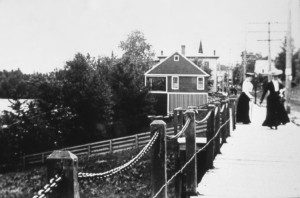Lake Placid Library History
In 1883, a group of Lake Placid residents decided the growing community needed a library. They called a public meeting on Jan. 15, 1884, where they would gather to discuss the venture at the Adirondack Baptist Church.
That day, 18 people “interested in the literary advancement of our community” formed the Library Association of North Elba. A month later, on Feb. 19, 1884, they filed a Certificate of Incorporation in the office of the Essex County Clerk, Mr. Roberts, who donated the cost of the filing.
Plans for the building began immediately. Two hundred books had already been donated, as well as several newspaper and magazine subscriptions. The group selected a plot between Mirror Lake and Main Street; it has been the site of the library ever since.
The land belonged to the Adirondack Baptist Church, which charged the Library Association a token rent of $1 a year. Every Jan. 1, the association paid the church a dollar, and on the same day, the church donated $1 to the Library Association. In effect, the property cost the library nothing— only the annual exchange of receipts was involved. The lease was to run for 50 years and was renewable for another 50.
Byron E. McLeod surveyed the plot for free, and James L. Breeze of New York City donated plans and specifications. R.W. Clifford built the library for $1,200.
The community generously donated time, raw materials, and cash. The dream of a few people had become that of the whole community. The Lake Placid Public Library opened its doors in July 1886. Lydia Wood was elected the first librarian, at a salary of $1 a week.
School District Library
Before 1900, the State Education Laws provided for the establishment of public libraries throughout New York. By transferring the library to the local school district under the supervision of the State University of New York, a firmer, more secure organization would result.
Voters of School District #2, Town of North Elba, elected five new trustees who were instructed to apply to the Regents of the University for a charter. At a meeting on December 10, 1894, the trustees officially transferred the ownership of the library to themselves as the new library board. The charter as a school district library was granted the same year.
The school district also appropriated $300 for the maintenance of the library, with an additional $100 expected through gifts and “entertainments.” The expenditure budget for the year was $200 for books, $25 for utilities, $75 for furniture and office supplies, and $100 for the librarian’s salary, twice what it was when the library opened. The library was now open at least an hour a day, three days a week. By 1896 the hours increased to 10 a week in the summer and 4½ a week in the winter.
New century
By 1900, Lake Placid installed a new sidewalk along Main Street, and the library was required to move the building back a few feet. The construction costs for raising and moving the library was $450, more than a third of the original construction 15 years earlier.
By the winter of 1901-1902, hours and days of service were extended and a new stove made the reading room more comfortable. Library records show that by 1902, holdings have increased to over 2,000 bound books in addition to newspapers and “several of the best magazines.”

Side view of the library, 1903.
The Dewey Influence
From its beginning, the library had enjoyed a working relationship with the librarian and fellow townsman, Melvil Dewey. He was the founder of the American Library Association and the first School of Library Science at Columbia University, and the inventor of a method of cataloging based on the decimal system, known as the Dewey Decimal System. He served as state librarian and as secretary to the Board of Regents of the University of the State of New York. In 1895, he and his wife, Annie, started a retreat for vacationing teachers, librarians, and other like-minded individuals who enjoyed the beautiful scenery and repose which the mountains offered. The retreat was the beginning of the renowned Lake Placid Club.
Dewey encouraged the growth of the young Lake Placid Library by donating $40 worth of newspaper and magazine subscriptions to the library if the trustees would agree to keep the building open six nights a week. In exchange for allowing Dewey’s guests to use the reading room and borrow books, the library billed him $40 a year. This arrangement continued until the Lake Placid Club built its own library.
Purchase of Library Property
Between World War I and II, the Baptist church sold the property on which the library stood to the Adirondack Finance Corporation (AFC). The AFC refused to acknowledge the friendly lease agreement and the annual exchange of a dollar between the church and the Library Association.
After years of controversy, the library board, the Lake Placid School Board, and Adirondack Finance Corporation reached an agreement for the school district to purchase the lot on which the library stood for $8,500. Voters ratified the agreement on July 14, 1936.
Expansion
Throughout the years, the Library has continued to acquire a good selection of books. As the collection grew, the library has expanded multiple times.
The enclosure of the back reading porch was completed in 1941. An addition of a separate children’s room and a reference room on the middle floor level was completed in June 1952. In that year, the library also made its final mortgage payment, owning its land at last.
In 1954, Lake Placid joined the Clinton-Essex Library System (Franklin County joined soon thereafter). The benefits included a larger book pool, in-depth reference, and better access to interlibrary loans. For its centennial year, the Board of Trustees marked the milestone with an expansion program. Rather than an addition, the focus was to more efficiently use the existing space. A steep, narrow stairway to the children’s room was replaced, and large picture windows were installed above it. The unheated and inaccessible basement became a large, bright office and cataloging room. Casement windows were installed overlooking the Main Street porch, entry steps were replaced and new floor tiles were placed in the main stack area.
The last expansion, completed in December 2000, included a three-story extension to the main building and the purchase and renovation of the Giambruno property next door. A connector was built between the buildings, and an elevator providing handicapped access was installed. A computer room is available in the new annex, as well as an art gallery and a community room.
- Lake Placid Public Library Archives:
https://nyheritage.org/contributors/lake-placid-public-library - Photos from the Plains of Abraham : The Mary MacKenzie Historic Slide Collection 333 historic photographs of North Elba
township and the village of Lake Placid,
Essex County, New York
Curated by Lee Manchester - NY Heritage Digital Collections:
https://nyheritage.org - Northern New York Historical Newspapers:
https://nyshistoricnewspapers.org - Lake Placid Club Archives Collection Guide PDF


